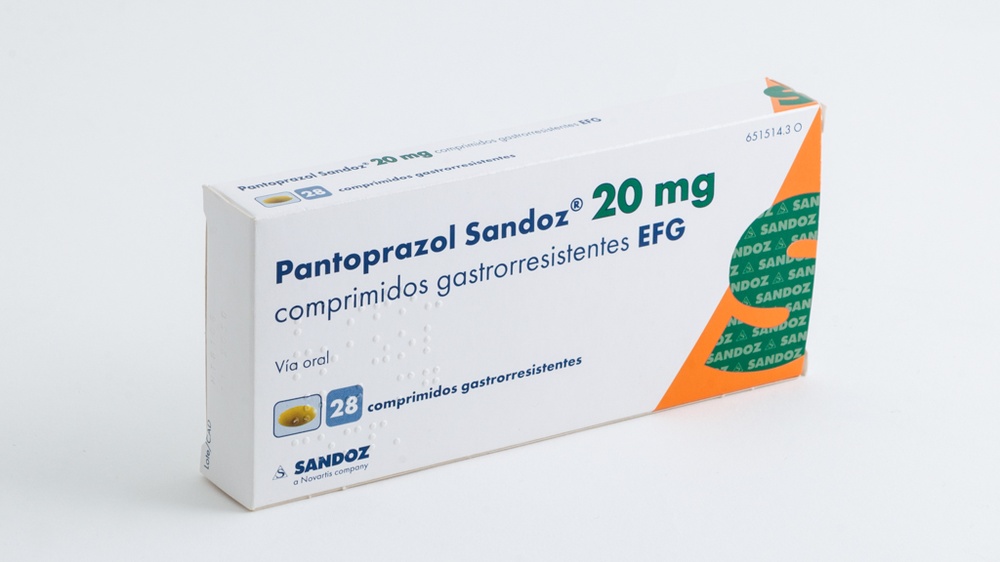

PANTOPRAZOL SANDOZ 20 mg GASTRO-RESISTANT TABLETS

Ask a doctor about a prescription for PANTOPRAZOL SANDOZ 20 mg GASTRO-RESISTANT TABLETS

How to use PANTOPRAZOL SANDOZ 20 mg GASTRO-RESISTANT TABLETS
Introduction
Package Leaflet: Information for the User
Pantoprazol Sandoz 20 mg Gastro-Resistant Tablets EFG
Read all of this leaflet carefully before you start taking this medicine because it contains important information for you.
- Keep this leaflet, you may need to read it again.
- If you have any further questions, ask your doctor, pharmacist, or nurse.
- This medicine has been prescribed for you only. Do not pass it on to others. It may harm them, even if their signs of illness are the same as yours.
- If you get any side effects, talk to your doctor, pharmacist, or nurse. This includes any possible side effects not listed in this leaflet. See section 4.
Contents of the pack and other information:
- What is Pantoprazol Sandoz and what is it used for
- What you need to know before you take Pantoprazol Sandoz
- How to take Pantoprazol Sandoz
- Possible side effects
- Storage of Pantoprazol Sandoz
- Contents of the pack and other information
1. What is Pantoprazol Sandoz and what is it used for
Pantoprazol Sandoz contains the active substance pantoprazole. Pantoprazole is a selective inhibitor of the "proton pump", a medicine that reduces the amount of acid produced in your stomach. It is used for the treatment of diseases related to stomach and intestine acid.
Pantoprazole is used to treat adults and adolescents from 12 years of age:
- Symptoms associated with gastroesophageal reflux disease (heartburn, acid regurgitation, pain when swallowing) caused by acid reflux from the stomach.
- Long-term treatment and prevention of relapses of reflux esophagitis (inflammation of the esophagus accompanied by acid regurgitation from the stomach).
Pantoprazole is used in adults for:
- Prevention of gastroduodenal ulcers induced by non-steroidal anti-inflammatory drugs (NSAIDs, e.g., ibuprofen) in patients at risk who require continued treatment with NSAIDs.
2. What you need to know before you take Pantoprazol Sandoz
Do not take Pantoprazol Sandoz
- if you are allergic to pantoprazole or any of the other ingredients of this medicine (listed in section 6),
- if you are allergic to medicines containing other proton pump inhibitors.
Warnings and precautions
Consult your doctor, pharmacist, or nurse before starting to take pantoprazole:
- if you have severe liver problems. Tell your doctor if you have ever had liver problems in the past. Your doctor will monitor your liver enzymes more frequently, especially when you are on long-term treatment with pantoprazole. If you have an increase in liver enzymes, treatment should be discontinued,
- if you need to take NSAID medicines continuously and take pantoprazole, as there is a greater risk of developing stomach and intestine complications. Any increased risk will be assessed according to your personal risk factors such as age (65 years or older), history of stomach or duodenal ulcers or stomach or intestinal bleeding,
- if you have reduced body stores of vitamin B12 or risk factors for this and receive long-term treatment with pantoprazole. Like all medicines that reduce acid, pantoprazole may reduce the absorption of vitamin B12. Consult your doctor if you notice any of the following symptoms, as they may indicate a vitamin B12 deficiency:
- Extreme fatigue or lack of energy
- Numbness
- Pain in the tongue or red tongue, mouth ulcers
- Muscle weakness
- Visual disturbances
- Memory problems, confusion, depression
- consult your doctor if you are taking HIV protease inhibitors such as atazanavir (for the treatment of HIV infection) at the same time as pantoprazole,
- taking a proton pump inhibitor like pantoprazole, especially for more than a year, may increase the risk of hip, wrist, or spine fractures. Tell your doctor if you have osteoporosis (reduced bone density) or if you have been told you are at risk of osteoporosis (e.g., if you are taking steroids).
- if you are taking pantoprazole for more than three months, your magnesium levels in the blood may decrease. Low magnesium levels can cause fatigue, muscle contractions, disorientation, convulsions, dizziness, increased heart rate. If you have any of these symptoms, see your doctor immediately. Low magnesium levels can also cause a decrease in potassium and calcium levels in the blood. Your doctor may decide to perform periodic blood tests to monitor magnesium levels,
- if you are scheduled to have a specific blood test (Chromogranin A),
- if you have ever had a skin reaction after treatment with a medicine similar to pantoprazole to reduce stomach acid,
If you experience a skin rash, especially in areas of the skin exposed to the sun, consult your doctor as soon as possible, as it may be necessary to discontinue treatment with pantoprazole. Remember to mention any other symptoms you may notice, such as joint pain.
Tell your doctor immediately, before or after taking this medicine, if you notice any of the following symptoms, which may be signs of more serious diseases:
- unintentional weight loss,
- vomiting, particularly if it is repeated,
- blood in the vomit: it may appear as a dark coffee grounds-like substance in your vomit,
- if you notice blood in your stools, which may appear black or dark,
- difficulty swallowing or pain when swallowing
- pale appearance and feeling of weakness (anemia),
- chest pain,
- stomach pain,
- severe or persistent diarrhea, as this medicine has been associated with a small increase in infectious diarrhea,
- cases of severe skin reactions have been reported in relation to treatment with pantoprazole, including Stevens-Johnson syndrome, toxic epidermal necrolysis, drug hypersensitivity with eosinophilia and systemic symptoms (DRESS), and erythema multiforme. Stop taking pantoprazole and contact your doctor immediately if you experience any of the symptoms related to severe skin reactions described in section 4.
Your doctor will decide if you need any additional tests to rule out a malignant disease because pantoprazole may alleviate the symptoms of cancer and could delay its diagnosis. If, despite treatment, your symptoms persist, complementary tests will be performed.
If you take pantoprazole for a prolonged period (more than a year), your doctor may monitor you regularly. You should inform your doctor of any new symptoms and/or events each time you visit your doctor.
Children and adolescents
The use of pantoprazole is not recommended in children as it has not been tested in children under 12 years of age.
Other medicines and Pantoprazol Sandoz
Tell your doctor or pharmacist if you are taking, have recently taken, or might take any other medicines.
This is because pantoprazole may affect the efficacy of other medicines, so inform your doctor if you are taking:
- medicines such as: ketoconazole, itraconazole, and posaconazole (used to treat fungal infections) or erlotinib (used to treat certain types of cancer), as pantoprazole may make these and other medicines not work properly,
- warfarin and phenprocoumon, which affect blood coagulation. You may need additional checks,
- medicines used to treat HIV infection, such as atazanavir,
- methotrexate (used to treat rheumatoid arthritis, psoriasis, and cancer). If you are taking methotrexate, your doctor may temporarily suspend treatment with pantoprazole, as pantoprazole may increase methotrexate levels in the blood,
- fluvoxamine (used to treat depression and other psychiatric disorders), if you are taking fluvoxamine, your doctor may reduce your dose,
- rifampicin (used to treat infections),
- St. John's Wort (Hypericum perforatum) (used to treat mild depression).
Talk to your doctor before taking pantoprazole if you need to have a specific urine test (for THC, tetrahydrocannabinol).
Pregnancy, breastfeeding, and fertility
There is not enough data on the use of pantoprazole in pregnant women. It has been reported that in humans, pantoprazole is excreted in breast milk.
If you are pregnant or breastfeeding, think you may be pregnant, or are planning to have a baby, ask your doctor or pharmacist for advice before taking this medicine.
You should only use this medicine if your doctor considers that the benefit for you is greater than the potential risk to the fetus or baby.
Driving and using machines
Pantoprazole has no or negligible influence on the ability to drive or use machines.
You should not drive or use machines if you experience side effects such as dizziness or blurred vision.
Pantoprazol Sandoz contains an azo colorant and sodium
This medicine may cause allergic reactions because it contains the azo colorant Ponceau 4R (E124).
This medicine contains less than 1 mmol of sodium (23 mg) per gastro-resistant tablet; this is essentially "sodium-free".
3. How to take Pantoprazol Sandoz
Take this medicine exactly as your doctor or pharmacist has told you. If you are not sure, ask your doctor or pharmacist.
Method of administration
Take the tablets whole, without chewing or crushing, with a little water, 1 hour before a meal.
The recommended dose is:
Adults and adolescents from 12 years
- For the treatment of symptoms associated with gastroesophageal reflux disease (heartburn, acid regurgitation, pain when swallowing)
The usual dose is one tablet per day.
This dose usually provides relief within 2 to 4 weeks, and if not, within the following 4 weeks. Your doctor will tell you how long you should take the medicine. After that, any recurring symptoms can be controlled by taking one tablet per day as needed.
- For long-term treatment and prevention of relapses of reflux esophagitis
The usual dose is one tablet per day. If the disease recurs, your doctor may double the dose, in which case you can take pantoprazole 40 mg once a day. After healing, you can reduce the dose back to one 20 mg tablet per day.
Adults
- For the prevention of duodenal and stomach ulcers in patients who need continued treatment with NSAIDs
The usual dose is one tablet per day.
Severe liver impairment
If you have severe liver problems, you should not take more than one 20 mg tablet per day.
Use in children and adolescents
The use of these tablets is not recommended in children under 12 years of age.
If you take more Pantoprazol Sandoz than you should
If you have taken more Pantoprazol Sandoz than you should, talk to your doctor, pharmacist, or contact the Toxicology Information Service, phone: 91 562 04 20, indicating the medicine and the amount used.
If you forget to take Pantoprazol Sandoz
Do not take a double dose to make up for forgotten doses. Take your next dose as usual.
If you stop taking Pantoprazol Sandoz
Do not stop taking these tablets without consulting your doctor or pharmacist first.
If you have any further questions on the use of this medicine, ask your doctor, pharmacist, or nurse.
4. Possible side effects
Like all medicines, this medicine can cause side effects, although not everybody gets them.
If you experience any of the following side effects, stop taking these tablets and inform your doctor immediately, or contact the emergency department of the nearest hospital.
- Severe allergic reactions (rare:may affect up to 1 in 1,000 people): swelling of the tongue and/or throat, difficulty swallowing, rash (urticaria), difficulty breathing, swelling of the face of allergic origin (angioedema), severe dizziness with rapid heartbeat and excessive sweating.
- Severe skin reactions (frequency not known:the frequency cannot be estimated from the available data): you may notice one or more of the following:
- blisters on the skin and rapid deterioration of general conditions, erosion (including slight bleeding) of eyes, nose, mouth/lips, or genitals, or skin sensitivity/particular rash in sun-exposed areas. You may also have joint pain or flu-like symptoms, fever, swollen lymph nodes (e.g., in the armpit), and blood tests may show changes in certain white blood cells or liver enzymes.
- Round or target-like red spots on the trunk, often with blisters in the center, peeling, mouth ulcers, throat ulcers, nasal ulcers, genital ulcers, and eye ulcers. These severe rashes can be preceded by fever and flu-like symptoms (Stevens-Johnson syndrome, toxic epidermal necrolysis).
- Generalized rash, high body temperature, and swollen lymph nodes (DRESS or drug hypersensitivity).
- Other serious conditions (frequency not known): yellowing of the skin and the whites of the eyes (severe liver cell damage, jaundice), or fever, rash, increase in kidney size with occasional pain when urinating, and lower back pain (severe kidney inflammation), which may lead to kidney failure.
Other possible side effects are:
- Common(may affect up to 1 in 10 people):
Benign stomach polyps.
- Uncommon(may affect up to 1 in 100 people):
headache; dizziness; diarrhea; feeling of dizziness, vomiting; swelling and flatulence (gas); constipation; dry mouth; abdominal pain and discomfort; skin rash, eczema, eruption; numbness; feeling of weakness, fatigue, or general malaise; sleep disturbances, hip, wrist, and spine fractures
- Rare(may affect up to 1 in 1,000 people):
alteration or complete loss of taste, vision disturbances such as: blurred vision; urticaria; joint pain; muscle pain; weight changes; increased body temperature; fever, swelling in the limbs (peripheral edema); allergic reactions; depression; breast enlargement in men.
- Very rare(may affect up to 1 in 10,000 people):
Disorientation.
- Frequency not known(cannot be estimated from the available data):
Hallucinations, confusion (especially in patients with a history of these symptoms),
numbness, tingling, burning sensation, or numbness, skin rash, possibly with joint pain, inflammation of the large intestine that causes persistent watery diarrhea.
Side effects identified through blood tests:
- Uncommon(may affect up to 1 in 100 people):
Increased liver enzymes.
- Rare(may affect up to 1 in 1,000 people):
increased bilirubin; increased blood fat levels, sudden drop in white blood cell count in the blood, associated with high fever.
- Very rare(may affect up to 1 in 10,000 people):
reduction in platelet count that could lead to bleeding or more bruising than usual; reduction in white and red blood cell count that could lead to more frequent infections, along with a decrease in white and red blood cell count in the blood, as well as platelet count.
- Frequency not known(the frequency cannot be estimated from the available data): decrease in sodium, magnesium, calcium, or potassium levels in the blood (see section 2).
Reporting of side effects:
If you experience any side effects, talk to your doctor, pharmacist, or nurse. This includes any possible side effects not listed in this leaflet. You can also report side effects directly through the Spanish Pharmacovigilance System for Human Use Medicines: https://www.notificaram.es. By reporting side effects, you can help provide more information on the safety of this medicine.
5. Storage of Pantoprazol Sandoz
Keep this medicine out of the sight and reach of children.
Do not use this medicine after the expiry date which is stated on the blister and on the carton after EXP. The expiry date is the last day of the month stated.
No special storage conditions are required.
Do not use this medicine 6 months after the first opening of the HDPE bottle.
Medicines should not be disposed of via wastewater or household waste. Ask your pharmacist how to dispose of medicines no longer required. These measures will help protect the environment.
6. Packaging Content and Additional Information
Pantoprazol Sandoz Composition
- The active ingredient is pantoprazol. Each gastro-resistant tablet contains 20 mg of pantoprazol (as sodium sesquihydrate).
- The other components (excipients) are:
Core:calcium stearate, microcrystalline cellulose, crospovidone (type A), hydroxypropylcellulose (type EXF), anhydrous sodium carbonate, anhydrous colloidal silica.
Coating:hypromellose, yellow iron oxide (E172), macrogol 400, methacrylic acid and ethyl acrylate copolymer (1:1), polysorbate 80, ponceau 4R (E124), quinoline yellow (E104), sodium lauryl sulfate, titanium dioxide (E171), triethyl citrate.
Product Appearance and Packaging Content
Pantoprazol Sandoz 20 mg are yellow, oval, gastro-resistant tablets (with a special coating), approximately 8.9 x 4.6 mm in size.
They are available in:
Blisters of 7, 10, 14, 15, 20, 28, 30, 50, 56, 56x1, 60, 84, 90, 98, 100, 100x1, 140, 168 tablets
Bottles of 14, 28, 56, 98, 100, 105, 250, 500 tablets.
Only some pack sizes may be marketed.
Marketing Authorization Holder and Manufacturer
Marketing Authorization Holder
Sandoz Farmacéutica, S.A.
Centro Empresarial Parque Norte
Edificio Roble
C/ Serrano Galvache, 56
28033 Madrid
Spain
Manufacturer
Lek Pharmaceuticals d.d.
Verovskova 57,
SLO-1526 Ljubljana
Slovenia
or
Lek Poslka Akcyjna
ul. Domaniewska 50 C,
02-672 Warszawa
Poland
or
Salutas Pharma GmbH
Otto-von-Guericke-Allee 1
39179 Barleben
Germany
or
Lek Pharmaceuticals d.d
Trimlini 2D, 9220
Lendava
Slovenia
or
Sandoz S.R.L.
Str. Livezeni nr. 7A,
RO-540472 Targu-Mures
Romania
or
Lek S.A.
Ul. Podlipie 16
95-010 Strykow
Poland
Date of the Last Revision of this Leaflet:February 2025
Detailed and updated information on this medicinal product is available on the website of the Spanish Agency for Medicines and Health Products (AEMPS) http://www.aemps.gob.es/

How much does PANTOPRAZOL SANDOZ 20 mg GASTRO-RESISTANT TABLETS cost in Spain ( 2025)?
The average price of PANTOPRAZOL SANDOZ 20 mg GASTRO-RESISTANT TABLETS in November, 2025 is around 8.74 EUR. Prices may vary depending on the region, pharmacy, and whether a prescription is required. Always check with a local pharmacy or online source for the most accurate information.
- Country of registration
- Average pharmacy price8.74 EUR
- Active substance
- Prescription requiredYes
- Manufacturer
- This information is for reference only and does not constitute medical advice. Always consult a licensed doctor before taking any medication. Oladoctor is not responsible for medical decisions based on this content.
- Alternatives to PANTOPRAZOL SANDOZ 20 mg GASTRO-RESISTANT TABLETSDosage form: TABLET, 40 mgActive substance: pantoprazoleManufacturer: Especialidades Farmaceuticas Centrum S.A.Prescription requiredDosage form: TABLET, 20 mg pantoprazoleActive substance: pantoprazoleManufacturer: Takeda GmbhPrescription requiredDosage form: TABLET, 40 mg pantoprazoleActive substance: pantoprazoleManufacturer: Takeda GmbhPrescription required
Alternatives to PANTOPRAZOL SANDOZ 20 mg GASTRO-RESISTANT TABLETS in other countries
The best alternatives with the same active ingredient and therapeutic effect.
Alternative to PANTOPRAZOL SANDOZ 20 mg GASTRO-RESISTANT TABLETS in Poland
Alternative to PANTOPRAZOL SANDOZ 20 mg GASTRO-RESISTANT TABLETS in Ukraine
Online doctors for PANTOPRAZOL SANDOZ 20 mg GASTRO-RESISTANT TABLETS
Discuss dosage, side effects, interactions, contraindications, and prescription renewal for PANTOPRAZOL SANDOZ 20 mg GASTRO-RESISTANT TABLETS – subject to medical assessment and local rules.














